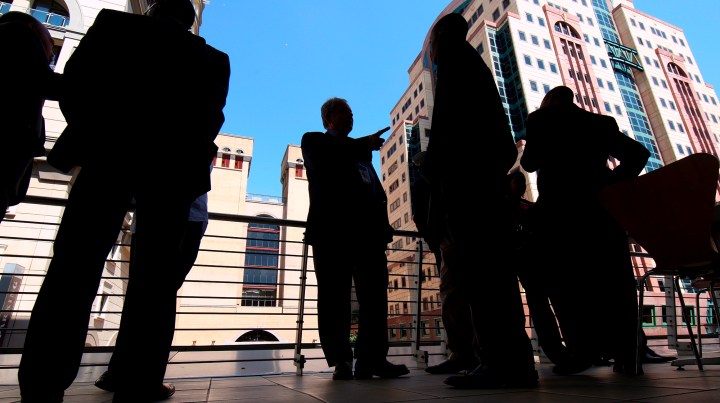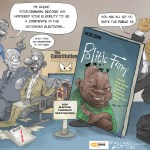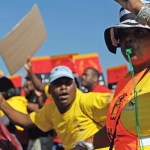Business Maverick
Ramaphoria has taken hold of the otherwise serially depressive S&P Global Ratings

In more than a year South Africa has gone from Ramaphoria, the burst of optimism about South Africa that was unleashed after the election of President Cyril Ramaphosa, to a sobering reality of political and economic crises. However, credit rating agency S&P Global Ratings is on a Ramaphoria high, expecting South Africa’s economy to grow by 1.6% in 2019. Meanwhile, economists expect growth of less than 1%.
When Cyril Ramaphosa became State President in February 2018, his arrival to Pretoria’s Union Buildings unleashed a surge of positive sentiment and investor confidence across the country.
People called the initial burst of goodwill “Ramaphoria” or the “Cyril dividend” – anticipating that it would spur consumer spending and private sector investments, which would, in turn, reboot South Africa’s broken economy. However, the euphoria abated as the nation has come to terms with the deep economic and political morass that the country faces.
South Africa’s challenges are well-known by now: Ramaphosa’s efforts to stabilise government finances to pursue economic and social reforms are yet to positively reflect on key indicators. State-owned enterprises (SOEs) continue to drain the fiscus, the nation is shocked by rampant corruption allegations emerging from several commissions of inquiries that are running concurrently, and rolling blackouts have intensified to uncomfortable levels.
Arguably, an election cycle – like the one South Africa is in at the moment – amplifies the volume of bad news, making challenges and crises feel more acute.
But there is a counterargument. At a conference in Johannesburg on Wednesday, credit rating agency S&P Global Ratings seems to be one of the few voices that still believe in “Ramaphoria” and the dividend that comes with it, judging from its unusually optimistic views on South Africa.
Unusual, because S&P is one of two credit rating agencies that rate South Africa’s creditworthiness at sub-investment grade (commonly known as junk). It is normally bearish in its assessment of the country. After all, the agency has been downgrading South Africa’s credit rating since 2012 as the country’s economic outlook and public finances deteriorated under the destructive Jacob Zuma years.
S&P is confident that a Ramaphosa-led government can grow the economy by 1.6% in 2019 – a forecast higher than those of National Treasury and the South African Reserve Bank, which have pencilled in growth of 1.5% and 1.3% respectively.
The rating agency’s hubris is based on reform efforts initiated by a business-friendly Ramaphosa including, among others, a $100-billion investment drive over the next five years and rebuilding the credibility of institutions such as the National Prosecuting Authority.
“We think the new administration that came in February 2018 can help South Africa grow above 1%. Our base-case scenario is that the ANC will win the upcoming general elections [on May 8] and they will continue with the reform efforts they started. South Africa is better with a reform-minded and united majority party, which is the ANC,” said S&P’s primary credit analyst for South Africa Gardner Rusike said at the agency’s annual conference in Johannesburg on Tuesday.
Rusike’s optimism prompted one senior economist to quip: “If you want to want to feel positive about South Africa, then you should look to S&P and attend their conference.”
Despite the agency being upbeat about South Africa, it doesn’t foresee an upgrade to the country’s credit rating. Rusike said S&P doesn’t foresee the domestic economy growing beyond 2% in the near future – a level that would, in theory, warrant a rating upgrade.
In November 2018, S&P kept South Africa’s long-term currency debt at BB+, the first notch of sub-investment grade, with a stable outlook. The long-term foreign currency rating is at BB, two notches below investment grade. Its next credit rating decision and economic growth update are expected on May 24.
Rusike said S&P’s 2019 growth forecast might be adjusted downwards to factor in the recent spate of rolling blackouts, which undermine Ramaphosa’s ambition to grow the economy. He remains resolute about the 1.6% figure despite Eskom, which supplies more than 90% of power in the country, being on the brink of collapse, saying the global environment and commodity prices remain supportive.
Other supportive factors include inflation that remains within the central bank’s 3% to 6% target range, which should provide stability in monetary policy implementation, a flexible exchange rate, and a rise in iron ore prices, which should benefit large exporters like South Africa.
Even with such growth positive exogenous factors, senior economists are taking S&P’s growth forecast with a pinch of salt. Both Econometrix’s Dr Azar Jammine and the South African Institute of Race Relations’ Ian Cruickshanks expect, at best, a growth of less than 1% in 2019.
“Business confidence is pointing to a shrinking rather than a growing economy. We’d be lucky if we record any positive growth this year,” Cruickshanks told Business Maverick.
Lending credence to Cruickshanks’ view is that two key economic indicators are pointing to a distressed economy. Business confidence fell to 27 index points in the first quarter of 2019, the lowest level in almost two years, according to Rand Merchant Bank and Stellenbosch’s Bureau for Economic Research. Absa Purchasing Managers’ Index fell for a third consecutive month in March to 45 points from 46.2 points in February, hit by a decline in business activity due to power cuts and lower new sales orders. A figure below 50 indicates contraction in the sector.
Jammine said South Africa needs to attract investments from the private sector, which he regards as a priority.
“If we don’t see an increase in fixed investments [assets and capital investment to start new and expand existing businesses], we won’t see much growth in the economy or job creation,” he said.
The consensus between Cruickshanks and Jammine is that no major economic growth and investment decisions will be taken by the government until elections are concluded. DM

















 Become an Insider
Become an Insider